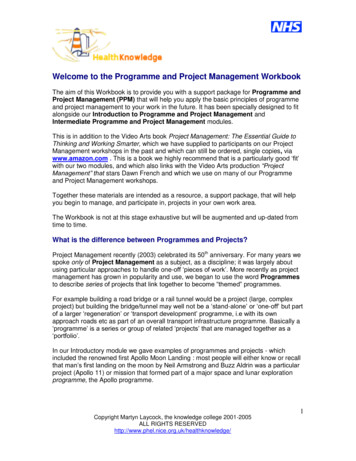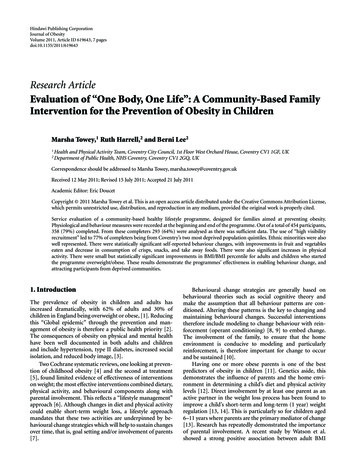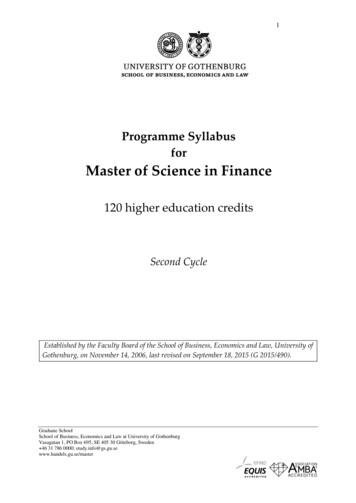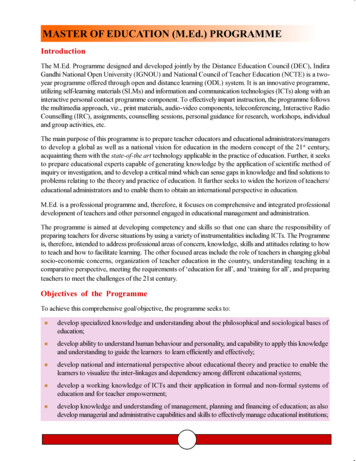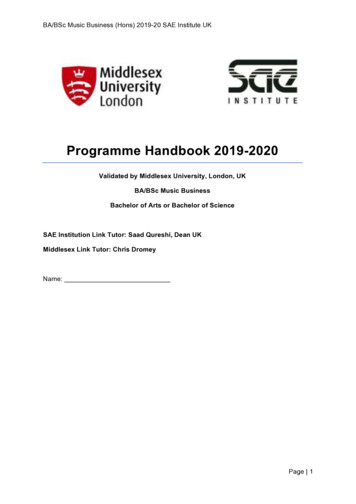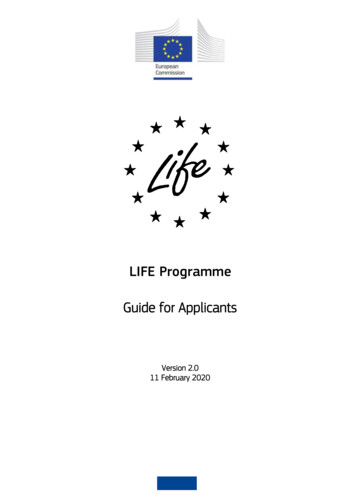
Transcription
LIFE ProgrammeGuide for ApplicantsVersion 2.011 February 2020
IMPORTANT NOTICEThe Guide for Applicants is a general user guide that aims to explain to applicants andbeneficiaries the main rules that apply to the evaluation of their proposals and management oftheir EU grants.It covers action grants awarded under the: LIFE Programme (Technical Assistance actions) pilot projectsmanaged by the Executive Agency for Small and Medium-sized Enterprises (EASME) through the EUFunding & Tenders Portal (‘Portal’).It is designed to be your main practical reference for preparing and submitting your proposal and— if successful — for managing your grant.As far as possible, please try to find the answers you need yourself (we have limited resourcesfor handling direct enquiries).All terms are explained in the Glossary.Details on processes and procedures are described in the Online Manual. The Online Manual alsocontains FAQs and detailed instructions for the Electronic Exchange System.A complete list of reference documents (including legislation, work programme and templates) canbe found on Portal Reference Documents.Contacting us directlyIf necessary, you can also contact us (via the EASME LIFE ENQUIRIES Helpdesk or, for ITquestions, the IT Helpdesk.Suggestions or comments on how we could improve this guide for future calls? Email us via our helpdesk:EASME LIFE ENQUIRIES Helpdesk.HISTORY OF CHANGESVersionPublicationdate1.004.04.2019 Initial version.2.011.02.2020 Added reference to Brexit/UK. PP FTP referencesChanges
EU Grants: Guidance — Guide for Applicants (action grants): V2.0 – 11.02.2020TABLE OF CONTENTS1. Legal framework . 42. Projects that will be funded — Eligibility conditions — Admissibility requirements —Exclusion grounds — Operational and financial capacity requirements — Awardcriteria . 43. Participants: Roles & responsibilities . 44. Type of grant . 55. How to submit your proposal . 65.1Preparing your submission . 75.2How to fill out your application . 85.3Help .135.4Submission — Acknowledgement of receipt — Complaints .136. Information on the evaluation results — Complaints . 137. Preparing your grant agreement & final legal checks . 148. Managing your grant . 14APPENDIX 1 — ELIGIBLE COSTS . 16APPENDIX 2 — LIST OF RECORDS & SUPPORTING DOCUMENTS PER COST CATEGORY . 523
EU Grants: Guidance — Guide for Applicants (action grants): V2.0 – 11.02.20201. Legal frameworkIf you are in any doubt about any issues mentioned in this guide, the legally bindingrules and conditions for the calls are in the following documents: Regulation 2018/1046 (EU Financial Regulation) the basic act (LIFE Regulation No 1293/2013) the EU work programmes (available on Portal Reference Documents) for each call: the call documents (available on Portal Reference Documents) the model grant agreements (available on Portal Reference Documents).2. Projects that will be funded — Eligibility conditions — Admissibilityrequirements — Exclusion grounds — Operational and financial capacityrequirements — Award criteriaThe types of projects and activities that will be funded are set out in the EU workprogramme and call document.Eligibility conditions, admissibility requirements, exclusion grounds, operational andfinancial capacity requirements and award criteria are explained in the call document.3. Participants: Roles & responsibilitiesApplicants are jointly responsible for their proposal. Each organisation is responsiblefor submitting correct information in the proposal. The coordinator submits theproposal on behalf (and in the name of) all applicants.After grant signature, they become jointly responsible for implementing the projectactivities (in accordance with part B of the proposal which becomes an annex to thegrant agreement if the project is selected for funding). If a project is not finished, thegrant may have to be reduced for everyone.For consortia, the coordinator is responsible for managing the project, submittingreports and deliverables and acting as intermediary for all contacts with us.The other beneficiaries must implement their part of the project and contribute tothe formal and administrative grant obligations (e.g. reporting, etc).Your project may involve certain types of third parties to help with the projectactivities (linked third parties ( ‘affiliated entities’), subcontractors, third parties givingin-kind contributions, partner organisations, etc).Linked third parties (if allowed in the call document) can participate fully in the grant,i.e. implement a part of the project in their own name and claim their own costs. Theyare in practice very similar to beneficiaries (except that they don’t sign the grantagreement).Both beneficiaries and linked third parties can use subcontractors to implementcertain parts of the project (and charge the price paid to the the subcontractor to thegrant).Moreover, they can also rely on in-kind contributions by third parties (if againstpayment, they can be charged as project costs; if for free they will be cost-neutral,i.e. can NOT be declared as project cost).4
EU Grants: Guidance — Guide for Applicants (action grants): V2.0 – 11.02.2020If you use third parties, they and their contribution must be mentioned (andjustified) in Part B of your application.Your consortium set-up must follow the roles of our grant agreements.Participants should be attributed their roles according to their real contribution to theproject. The main actors should be the beneficiaries. All other roles should performsecondary tasks.This means for instance that:olinked third parties — are allowed to fully participate in the action, like thebeneficiary they are linked to; they will therefore be treated for many issueslike beneficiaries; beneficiaries are fully liable for their linked third partiesosubcontracting —obeneficiaries/linked third parties may NOT subcontract tasks to otherbeneficiaries/linked third partiesocore tasks of the project may NOT be subcontracted(generallysubcontracting of 35% of the total eligible cost or more will besubject to specific justification, unless specified otherwise in the calldocument)ocoordinator tasks — the key coordinator tasks listed in the grant agreementmay NOT be subcontracted (or delegated to another beneficiary); they mayhowever be performed by a linked third party of the coordinatoroin-kind contributions between beneficiaries/linked third parties — ifbeneficiaries/linked third parties give in-kind contributions to otherbeneficiaries/linked third parties, their cost can normally simply be declaredby the contributing beneficiary/linked third party (if the contributions areparticularly important for the project, it may however make sense tospecifically mention them in the description of the action)In the interests of equal treatment during the evaluation, you must NOT changeyour consortium set-up after you have submitted your project proposal.Operating grants — Operating grants are by definition mono-beneficiary grantswithout linked third parties (NOT allowed). Otherwise the same third party rulesapply as for action grants (subcontracting, in-kind contributions, etc).FPA/SGA — The consortium composition must be identical at FPA and SGA level;partners/linked third parties that do not want to actively participate in a specificaction may however participate as silent partners (‘partners not carrying out actiontasks’).4. Type of grantThe grant is a reimbursement of eligible costs grant.This means that it reimburses ONLY the costs you actually incur for your project (NOTthe budgeted costs).The costs will be reimbursed at the reimbursement rate and up to the maximumgrant amount fixed in the grant agreement.The grant will be paid out in one or more parts: pre-financing payment(s) (if foreseen in the grant agreement) — designed toprovide beneficiaries with a float; normally paid at the beginning of the project5
EU Grants: Guidance — Guide for Applicants (action grants): V2.0 – 11.02.2020 interim payment(s) (if foreseen in the grant agreement) — reimburse costsincurred for project implementation (during the corresponding reportingperiod); paid on receipt and approval of the periodic report payment of the balance — reimburses the outstanding part of the costsincurred for the project implementation; calculated as the difference of totalamount due and payments already made; paid on receipt and approval of thefinal report.If the total amount of earlier payments is greater than the final grant amount,we will have to recover the difference (i.e. you will have to pay back money).Types of grants — The standard format for all EU grants is a simple action grant (i.e. agrant agreement for implementing a project). Exceptionally, our grants support however notindividual projects, but the functioning of organisations (operating grants) or are given intwo phases (first award of a framework partnership (FPA) and then specific grants underthe framework partnership).5. How to submit your proposalAll proposals must be submitted directly online via the Portal Submission SystemSystem. Paper applications are no longer accepted.The submission process is explained in the Online Manual (together with detailedinstructions for the IT tool).Submission is a 2-step process:a) register your organisationb) submit the proposal — in 3 parts, as follows: Part A includes administrative information about the applicantorganisations (future coordinator and beneficiaries) and the summarisedbudget for the proposalFill in directly online. Part B (description of the action) covers the technical content of theproposal.Fill in the word template and upload as PDF file. annexes (if required in the call document).Upload as PDF files.The proposal must be submitted before the call deadline (specified in the calldocument). If you miss the deadline, your proposal will be automatically disregardedby the system and considered not to have been submitted.The proposal must keep to the page limits (specified in the proposal form); excesspages will be disregarded.Documents must be uploaded to the right category (otherwise your proposal mightbe incomplete and so inadmissible).You can submit your proposal in any official EU language. However, for reasons ofefficiency, we strongly advise you to use English. If you need the call document inanother official EU language, please submit a request (within 10 days after callpublication via the contact information mentioned in the call for proposals).6
EU Grants: Guidance — Guide for Applicants (action grants): V2.0 – 11.02.2020We strongly advise you to complete your proposal sufficiently in advance of thedeadline, to avoid any last minute problems. Any technical problems due to lastminute submissions (e.g. congestion, etc.) will be at your risk. The call deadline willNOT be extended.Even though you can save successive versions of your application as you go, weencourage you to preview the proposal templates before starting the online submissionprocess (sample text can be downloaded from Portal Reference Documents).To complete part A, all applicants must be registered in the Participant Registerand have communicated their PIC to the coordinator. Linked third parties must alsoregister, but later on during grant preparation. Subcontractors or in-kind contributorsdo NOT need to register.You may submit several proposals (and an organisation may participate in severalapplications), however those proposals must be for different projects.If you have made several applications for the same project, you will be asked to clarifywhich application you would like us to evaluate (projects may normally receive only onegrant from the EU budget).If you submit Part B of the proposal in a language other than English, please writeyour abstract/project summary (both in Part A and in Part B) in English.Actions byinvitation — Please note that for actions by invitation NO call is published on thePortal (no Call Topic page). All information will be communicated directly to theapplicants (by email).5.1Preparing your submissionYou must do 3 things before submitting your application: read the key background documents: Multi-annual work programme and calldocument create an EULogin user account (if you don't already have one; former ECASaccount) register your organisation in the Participant Register.Read the background documentsCheck whether: your project falls within the scope of the call/topic your organisation/proposal meets the eligibility criteriaand inform yourself about the: award criteria financial and operational capacity requirements exclusion criteria admissibility conditions (e.g. call deadline, page-limits, etc.) other (e.g. pre-financing guarantees).7
EU Grants: Guidance — Guide for Applicants (action grants): V2.0 – 11.02.2020For UK applicants: Please note that following the entry into force of the EU-UKWithdrawal Agreement1 on 1 February 2020 (and in particular Articles 127(6), 137and 138), the references to natural or legal persons residing or established in an EUMember State are in principle to be understood as including persons residing orestablished in the United Kingdom. UK entities therefore remain eligible to participatein EU calls.Create a user accountTo use the Portal Electronic Submission System (the only way to apply), allparticipants need to create an EULogin user account.Register your organisation in the Participant RegisterOnce you have an EULogin account, you can register your organisation in theParticipant Register.When your registration is finalised, you will receive a 9-digit participant identificationcode (PIC). You will need the PIC numbers (for the coordinator and the otherapplicants) to complete Part A of the application. PICs of linked third parties are notneeded at this stage (they will have to register later on).The person who registered the organisation can submit updates and corrections(including supporting documents) at any point before the call deadline (afterwardsthis can be done only by the legal entity appointed representative (LEAR)).You don't need to complete the registration process in a single session. You can entersome information, save it and continue later.5.21How to fill out your applicationAgreement on the withdrawal of the United Kingdom of Great Britain and Northern Ireland from theEuropean Union and the European Atomic Energy Community (OJ 2020 L 29, 31.1.2020, p.7).8
EU Grants: Guidance — Guide for Applicants (action grants): V2.0 – 11.02.2020To give your proposal the best chance of being selected for funding, make sure itis: relevant — address the relevant priorities in the topic. complete — include all the relevant information. Follow closely the format ofthe template in part B and ensure you upload all the information requested. clear & concise — don't interpret completeness as a requirement to includeas much information (and words) as possible. Your proposal must also beeasy to understand, precise and focused on substance.Respect the page limit. Do not repeat information. management-focused — clearly indicate the resources you will allocate tomanaging the intended activities, especially financial management (ensuringthe funding you are requesting will be adequate to finance the plannedactivities). results/impact-oriented — clearly show the results that will be achieved,and how you intend to disseminate/use them. Include a sound and credibleevaluation plan, not only focusing on process evaluation, but also looking atoutcomes.Operating grants & FPA/SGAs — Operating grants and FPAs/SGAs have slightlydifferent proposal forms, but the overall idea is the same: we need a detaileddescription in order to evaluate the quality of the proposal and whether it complieswith all the conditions for funding.Part A — Administrative formsPart A of the Proposal Template must be filled out directly online.List of ParticipantsThis section should list the organisations that wish to participate as beneficiaries.Other participants (linked third parties, subcontractors, etc.) should only bementioned in Part B of the Proposal Template.All applicants must also register in the Participant Register before proposal submission.Linked third parties can register later on (during grant preparation). Other third parties(subcontractors, in-kind contributors) do not need to register.Contact detailsPlease make sure the e-mail address you give is correct, working, and checked on aregular basis — we may have to contact you for more information, when evaluatingyour proposal.Budget overview tableThe budget overview table (in Part A of the Proposal Template) should show the totalestimated expenditure and receipts for each applicant, per budget category.9
EU Grants: Guidance — Guide for Applicants (action grants): V2.0 – 11.02.2020ColumnBudget categoryADirect personnel costsIndicate costs for personnel. Include only persons working on the action (and onlyfor their estimated time of work on the action).BDirect costs of subcontractingIndicate costs for subcontracted action tasks.CCosts of financial support to third partiesNot applicableDOther direct costsInclude (1) Travel cost and related subsistence allowances, (2) depreciation costsof equipment infrastructure or other assets (3) costs of other goods and services.FIndirect costsAutomatically calculated (at the indirect cost flat-rate set out in the calldocument).GTotal costsAutomatically calculated.HReceiptsIndicate project-generated income and financial contributions from third partiesthat are specifically to be used to cover eligible costs.IReimbursement ratePre-filled (at the reimbursement rate set out in the call document).The beneficiaries are free to decide on different arrangements within theconsortium (but these arrangements must stay consortium-internal and have noimpact on the grant agreement/relation with us).JMaximum EU contributionAutomatically calculated.KRequested EU contributionIndicate the amount of EU funding you would like to have for the project.The beneficiaries are free to decide on different arrangements within theconsortium (but these arrangements must stay consortium-internal and have noimpact on the grant agreement/relation with us).Only the white cells of the budget table in the Submission System need to be filled in(the grey cells are not applicable or automatically filled by the system).10
EU Grants: Guidance — Guide for Applicants (action grants): V2.0 – 11.02.2020The budgeted costs should be based on a detailed and accurate estimation of yourestimated project costs (based on the cost eligibility rules set out in Article 6 of thegrant agreement and Appendix 1 to this guide) and further clarified in the detailedbudget table.They should include all your estimated costs (including those of your linked thirdparties).You may include only eligible costs (i.e. costs that fulfil the eligibility conditions).Keep your estimates on file — you may be required to produce them later on.Part B — Description of the action (DoA)Project abstract, context & needs analysis, aim & objectives, methodologyThese sections should address the award criteria set out in the call document andinclude a pitch for the project, its context, aims and objectives and methodology.Work packages & activitiesAll project activities must be grouped in a logical, consistent and structured way intoseparate work packages.All work packages must present a clear, logical link to the project objectives and tothe other work packages.Ideally, each work package should constitute a sub-part of the project, a stepleading to the achievement of the project’s overall goals.Each project must have at least 2 work packages: work package1 — management and coordination activities work package 2 — outputs related to the project goals.Beyond that, create only as many as you need. Don’t use too many work packages;try to limit them to 5 or 6.For work package 1, enter all activities related to the general management andcoordination of the project (and any activities that do not relate to any of the workpackages leading to a specific result, but which are directly linked to the project as awhole).You are strongly advised to limit the costs of management and coordination to theminimum necessary.Most of your project spending should be on the activities needed to achieve theproject results.For the other work packages, describe for each work package: its objective(s) the activities to be implemented — in specific terms the (tangible and intangible) output(s) to be produced.Concerning the outputs:1. Distinguish between milestones and deliverables:11
EU Grants: Guidance — Guide for Applicants (action grants): V2.0 – 11.02.2020 milestones: control points in the project that help to chart progress(e.g. kick-off meetings, steering committes, first-draft of a survey,prototype, etc.) deliverables: outputs to be submitted to the EU (e.g. publication,leaflet, progress report, etc.)2. Be as specific as possible, e.g.: events — the number of events, title, content, duration, number ofparticipants, etc. publications — number of pages, language, format (e.g. printed/electronic), number of printed copies (in each language), etc.3. Be realistic about what you can achieve within the project duration. The scopeof your project should be large enough to make a difference, but it doesn't need toproduce an excessively high number of outputs.4. If relevant, outputs can also be internal (i.e. necessary for managing/coordinating/monitoring the project) or refer to intermediate stages of the project(e.g. questionnaires for a survey whose results will be a final outcome).Annexes & supporting documentsUse the forms provided inside the Submission System (not the documents available onthe Reference Documents or Call Topic page — they are only for information).Please be aware that if your proposal is sucessful, you will be asked to submit furtherdocuments later on (e.g. detailed budget table, financial documents, legal entityvalidation documents, LEAR appointment documents, etc).Detailed budget tableThe detailed budget table (annex to Part B) should show the detailed budgetbreakdown of the estimated costs in the Part A budget overview table.It will be taken into account for the evaluation (cost efficiency).The itemised expenditure should match the project activities described in Part B andlinked to the work packages for which they will be used.The detailed budget table must be in line with the amounts entered into the Part Abudget overview table.You should budget ONLY eligible costs (see the grant agreement and the Appendix1 to this guide).Keep your estimates on file (you may be required to produce them later on).Technical instructions for the detailed budget table:Sheets 3 and 4 have to be completed by each beneficiary/linked third party inseparate excel documents. Sheet 5 should be filled in by the coordinator manually —after having all the information by the other beneficiaries.Combine into a single PDF:1. Save sheets 3 and 4 into one PDF per beneficiary/linked third party (choosesheets via ‘Options’ when saving as PDF)12
EU Grants: Guidance — Guide for Applicants (action grants): V2.0 – 11.02.20202. Save sheets 3, 4 and 5 into a PDF for the coordinator.3. Combine into a single PDF for upload (using Adobe Acrobat or the Preview Appon Apple Macs).4. Upload in the Submission System (No need to upload the excel files).Other annexesFor other annexes consult the call document.5.3HelpAs far as possible, please try to find the answers you need yourself, in this andthe other documentation (we have limited resources for handling direct enquiries): Online Manual FAQs on the Call Topic page (for call-specific questions in open calls; notapplicable for actions by invitation) Portal FAQ (for general questions)Please consult the Call Topic page regularly, since we will publish new information(e.g. call updates).If you feel you have no other option, you can contact us as follows: IT Helpdesk — for technical questions about the Funding & Tenders PortalSubmission System (forgotten passwords, access rights and roles,technical aspects of proposal submission, etc.). Other questions — use our mailbox: EASME LIFE ENQUIRIES Helpdesk.Questions on submission must be:5.4 sent at the latest 7 days before the submission deadline indicating clearly the reference of the call/topic you are interested in orapplying to (see call document cover page).Submission — Acknowledgement of receipt — ComplaintsOnce the proposal is submitted, you will receive a confirmation e-mail (with date andtime of your application).If you do not receive this email, it means your proposal has NOT been submitted.If you believe this is due to a fault in the Electronic Submission System, you shouldimmediately file a complaint via the IT Helpdesk, explaining the circumstances andattaching a copy of the proposal (and, if possible, screenshots to show what happened).6. Information on the evaluation results — ComplaintsAfter submission, you will normally not hear from us until after evaluation — unlesswe need to clarify matters such as eligibility or request additional information.We will check eligibility and admissibility and evaluate your proposal against theaward criteria set out in the call document.13
EU Grants: Guidance — Guide for Applicants (action grants): V2.0 – 11.02.2020Proposals that do not pass the evaluation will receive a letter at the end of evaluation.To ensure equal treatment for all applicants, we can NOT answer any questions on theoutcome of the call before the evaluation is completed.If you believe that the evaluation procedure was flawed you will be able to submit acomplaint (following the deadlines and procedures set out in the evaluation result letter).Please note that notifications which have not been accessed within 10 days after sendingare considered to have been accessed and that deadlines will be counted as from thisday.7. Preparing your grant agreement & final legal checksSucessful proposals will be invited to prepare the grant agreement directly online inthe Portal (so-called ‘grant preparation’).At the same time, you will be requested to submit your financial data and appointyour LEAR and we will finalise the mandatory legal checks (legal entity validation,operational and financial capacity, exclusion and double funding).If all requirements are fulfilled, you will receive an invitation to sign your grantagreement (signature first by the coordinator on behalf of the consortium and then bythe EU). The other beneficiaries must then accede to the grant agreement by signingan Accession Form (also directly in the Portal).Our model grant agreement clauses are mandatory and the same for all beneficiaries.8. Managing your grantYour grant will be managed exclusively via the the Portal Grant Management System.Paper or e-mail communications are no longer accepted.The system will prompt any action on your side via PNS e-mail notifications.For a successful proposal implementation, we mainly require the following: implement the project as described in the description of the action (DoA)and report regularly by filling out the information in the:oPortal Continuous Reporting Module — always open (for submission ofdeliverables and reporting on milestones, critical risks, summary forpublication etc.)oPortal Periodic Reporting Module — open only at the end of thereporting period(s) (for periodic and final reports)Proper project implementation will allow us to process your reports quickly and makethe payments provided for in the grant agreement.14
EU Grants: Guidance — Guide for Applicants (action grants): V2.0 – 11.02.2020Payments will be made exclusively to the coordinator (who must distribute themwithout delay).You will be prompted to submit a financial statement to request payment of thecosts incurred during the reporting period.You should declare ONLY the eligible costs actually incurred for the projectimplementation (NOT the budgeted costs or other ineligible costs; see the grantagreement and the Appendix 1 to this guide).Budget transfers may be subject to ceilings/limitations (see the grant agreement).Beyond those ceilings/limits, you will have to request a formal amendment.Bear in mind that certain obligations under the grant agreement depend on yourshare in the estimated budget (e.g. liability for consortium debts, grant reductionsetc). It is therefore generally advised to request an amendment towards the end ofthe action, to align the estimated budget to the project implementation.Keep your calculations on file (you may be required to produce them later on andduring an audit you will have to show how each cost item you declared can bereconciled with your accounts).15
EU Grants: Guidance — Guide for Applicants (action gran
Guide for Applicants is a general user guide that aims to explain to applicants and the main rules that apply to the evaluation of their proposals and management of their EU grants. It covers action grants awarded under the: LIFE




